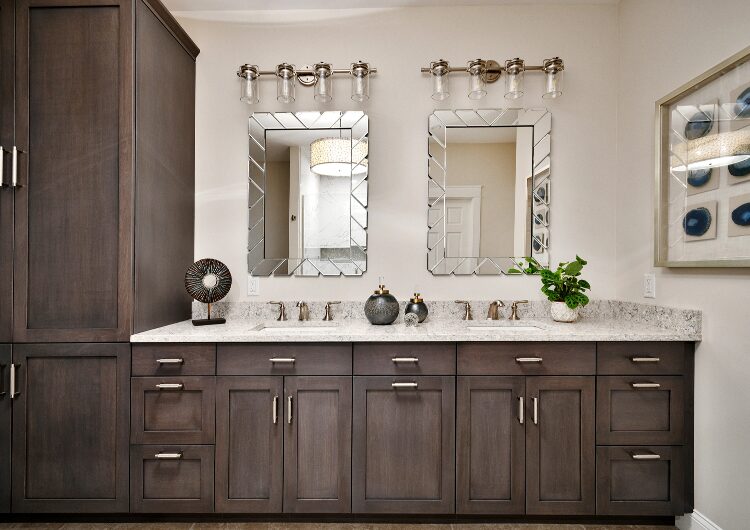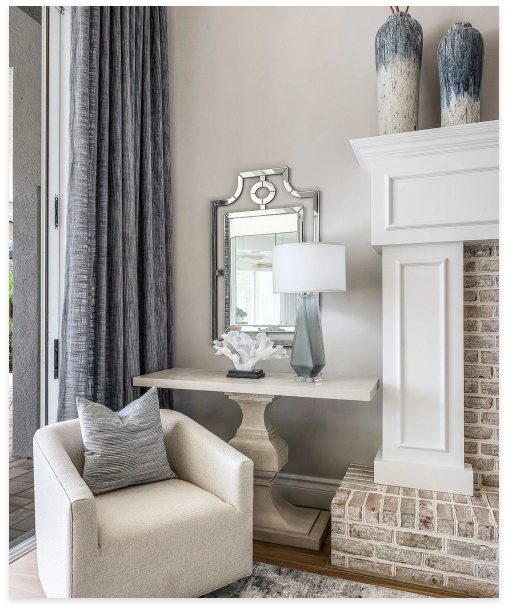Does that sound like just the look you’re going for?
FIND OUT EVERYTHING YOU NEED TO KNOW ABOUT THIS POPULAR DESIGN STYLE, INCLUDING ITS KEY DESIGN PRINCIPLES AND CHARACTERISTICS, WHICH TYPES OF FURNITURE WORK WELL IN TRANSITIONAL SPACES, APPROPRIATE COLOR PALETTES AND MORE.
Transitional Furniture and Decor
When it comes to transitional decor and furniture items, maintaining balance is key.
Sofas, armchairs and ottomans upholstered in neutral fabrics like linen, cotton or leather are popular choices for this design style. Clean lines and simple silhouettes characterize transitional seating pieces, which are often made out of materials like wood, metal and glass.
While transitional design favors neutral colors, subtle patterns can add visual interest without overpowering the space — like geometric prints, stripes or tone-on-tone patterns on upholstery, rugs and throw pillows.
And, don’t forget to mix traditional furniture with more contemporary furniture for a true transitional look. For example, a transitional living room might feature a classic wingback chair paired with a sleek, modern side table with reflective legs.
As far as decor goes, always opt for simple, elegant objects that don’t compete for your attention, but rather blend seamlessly with the rest of the living space.

Transitional Design Color Palettes
Transitional colors favor neutrality, softness and freshness over bolder or darker palettes. Think of adjectives like:
- Subtle.
- Sophisticated.
- Timeless.
- Balanced.
- Elegant.
- Soft.
- Gentle.
Here are a few color combinations to inspire your transitional interior transformation:
Color Palette Idea #1: Soft Neutrals With Warm Accents
Transitional spaces are meant to be warm and inviting. To create a space you and your guests feel welcome in, try:
- Walls: Cream, beige or light gray.
- Accents: Warm tones like caramel, taupe or soft brown.
- Pops of color: Subtle touches of muted blues, greens or a nice dusty rose.
Color Palette Idea #2: Gray With Metallic Accents
Gray is a staple color in this design style, which pairs excellently with contemporary metallic accents. For a more modern-leaning approach to transitional design, try:
- Walls: Light to medium gray.
- Accents: Metallic finishes such as brushed nickel, polished chrome or brass.
- Pops of color: Deep navy blue, emerald green or burgundy for contrast.
Color Palette Idea #3: Warm Earth Tones
Natural earth tones are right at home with a transitional style. For a warm, natural vibe, consider this color scheme:
- Walls: Warm taupe, sandy beige or terracotta.
- Accents: Rich wood tones like walnut or mahogany.
- Pops of color: Burnt orange, mustard yellow or olive green for warmth.
Color Palette Idea #4: White With Subtle Pastels
A white, bright palette is common in transitional style interior design. If this is your style, consider the following crisp color scheme:
- Walls: White or off-white.
- Accents: Soft pastel colors like blush pink, pale blue or mint green.
- Pops of color: Accents in deeper shades such as dusty plum or sage green.
Color Palette Idea #5: Monochromatic With Textured Accents
Finally, a monochromatic color palette marries traditional and contemporary styles together quite well. Supplement it with textured accents for added visual appeal and you’ll be well on your way:
- Walls: Various shades of a single color, like grays or beiges.
- Accents: Textured elements like woven fabrics, rough-hewn wood or hammered metal.
- Pops of color: Sparse use of a contrasting color like navy blue or charcoal for depth.
Transitional Lighting
Modern lighting takes center stage in transitional interiors. Layered lighting schemes help create balance in transitional spaces — which is one of the core tenets of the style.
From chandeliers to wall sconces, these common transitional lighting styles abound in this popular interior aesthetic:
Chandeliers
Transitional chandeliers often feature simple silhouettes with subtle decorative elements, incorporating materials like brushed nickel, bronze or crystal for added sophistication.
Pendant lights
Pendant lights
in transitional spaces tend to have understated designs with clean shapes and finishes, and can be used over kitchen islands, dining tables or entryways to provide both ambient and task lighting.


Lush mounts and semi-flush mounts
Flush mounts and semi-flush mount fixtures are popular in areas with lower ceilings.
Wall sconces
Transitional wall sconces typically come in neutral colors like black, bronze, brushed nickel or chrome to blend seamlessly with their surroundings. Like other elements of this design style, minimal ornamentation and gentle curves are common for this type of lighting.

Create Your Dream Transitional Home
Conjuring the perfect balance between traditional and contemporary styles to create a quintessential transitional space can be challenging.
Professional decorators can help you achieve your ideal transitional-style home while you sit back, relax and watch your dream living space come together.
Our team of expert decorators will work with you to understand your wants, needs and design preferences to curate a transitional interior you’ll be proud to call your own.
Curious about other interior styles? Take our design quiz and find out which style suits you best.
TAKE QUIZReady to create the transitional home of your dreams with the help of a Decorating Den Interiors designer?
Find your local designer to get started
GET STARTED
